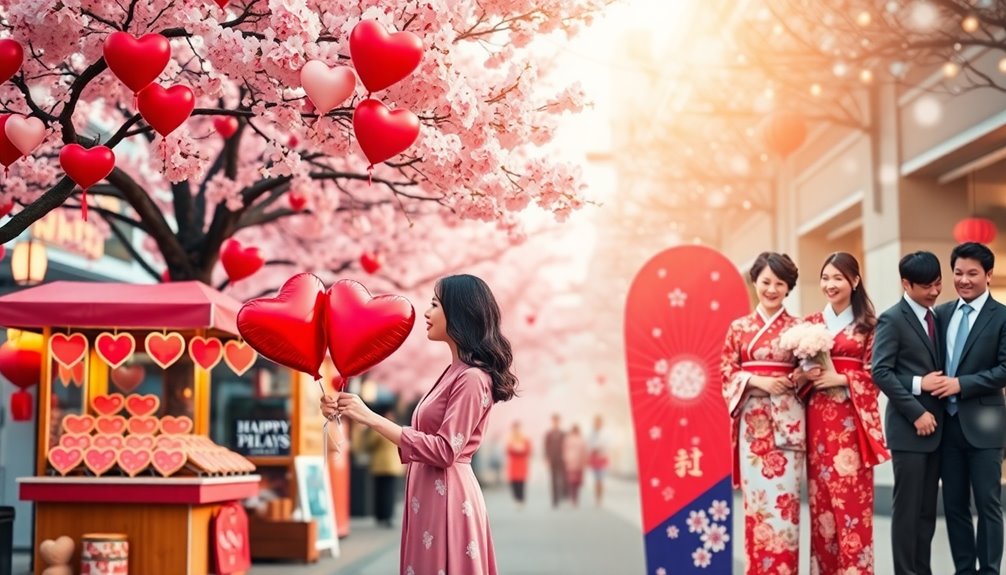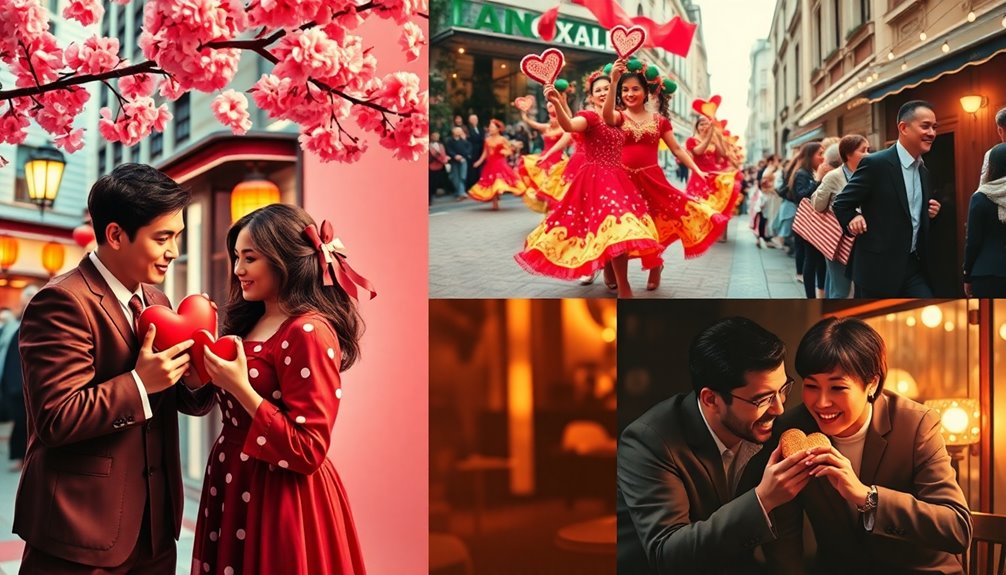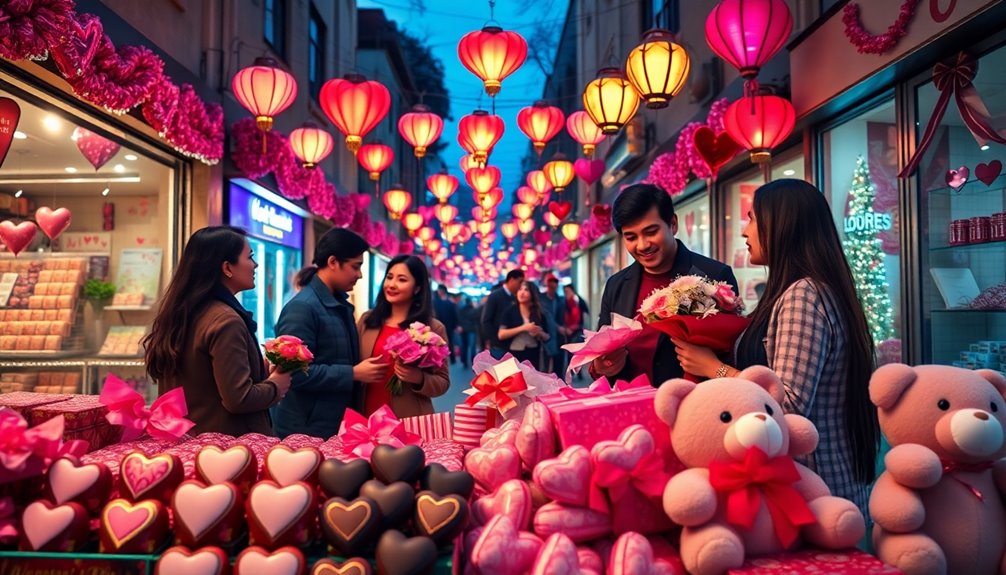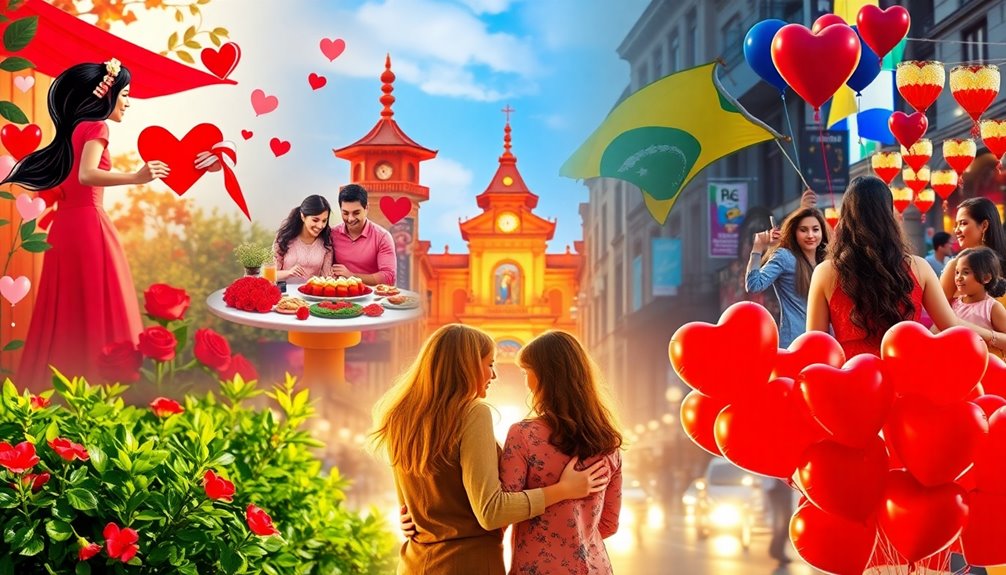Valentine's traditions have spread across the globe, shaping how you express love. From Japan's chocolate-giving custom to South Korea's three-month celebration, each culture brings its own flavor to the day. In the Philippines, mass wedding ceremonies blend tradition and romance, while Denmark's playful gaekkebrev adds a unique twist. As consumerism drives gift-giving trends, the essence of love evolves. Discover how these customs continue to transform and enrich your celebrations of love and affection.
Key Takeaways
- Valentine's Day has evolved from its Roman origins to a global celebration, adapting diverse cultural practices along the way.
- Various countries incorporate unique traditions, such as South Korea's three-month observance and Japan's chocolate gift-giving.
- Globalization has led to the adoption of Western customs, with countries like China embracing gift-giving and romantic dinners.
- Consumerism plays a significant role, with significant spending reflecting the influence of global trends on romantic expressions.
- Cultural interpretations of love vary, as seen in Indonesia's emphasis on collective happiness and South Korea's gender-specific gift-giving roles.
The Origins of Valentine's Day: A Historical Overview

Though many people associate Valentine's Day with flowers and chocolates, its origins date back to the Roman Empire and the martyrdom of Saint Valentine, who was executed on February 14, around 269 AD.
The celebration took shape during the Middle Ages, intertwining with themes of courtly love and romantic poetry.
You might be surprised to learn that the first known Valentine's Day card was sent by Charles, Duke of Orleans, to his wife in 1415 while he was imprisoned in the Tower of London.
By the 18th century, exchanging handwritten notes became common in England, paving the way for modern practices.
The 19th century saw the commercialization of Valentine's Day, leading to the mass production of greeting cards and significant consumer spending on gifts.
Valentine's Day Celebrations Across Continents

As you explore Valentine's Day celebrations around the world, you'll notice a rich tapestry of unique cultural practices and regional gift trends.
Each continent adds its own flair to expressing affection, from Japan's chocolate exchanges to Brazil's Couples Day.
Let's take a closer look at how these traditions evolve and shape the way love is celebrated globally.
Unique Cultural Practices Worldwide
Valentine's Day isn't just about roses and chocolates; it's a vibrant tapestry of unique cultural practices celebrated around the world.
In South Korea, you'll find a three-month observance, culminating in Black Day, where singles gather to eat jajangmyeon and celebrate love in their own way.
Denmark delights in the exchange of snowdrops and playful anonymous letters called Gaekkebrev, adding humor to the day.
The Philippines stands out with mass wedding ceremonies on February 14, allowing couples to publicly renew their vows.
Meanwhile, in Japan, women give chocolates on Valentine's Day, while men reciprocate with gifts on White Day.
Each of these Valentines Day traditions reflects the diverse ways people celebrate love across cultures. Additionally, just like Brazilian cuisine showcases regional variations, these traditions highlight the unique ways love is expressed around the globe.
Regional Gift Trends Evolving
When it comes to celebrating love, gift trends are evolving across continents, reflecting local customs and individual preferences. On Valentine's Day, couples worldwide are increasingly drawn to personalized gifts that tell their unique love stories.
In Japan, women traditionally give chocolates, while men reciprocate on White Day, creating a two-part celebration. Meanwhile, South Korea embraces a three-month cycle of love events, culminating in Black Day, where singles gather to enjoy jajangmyeon.
In Brazil, Couples Day on June 12 takes precedence, focusing on romantic dinners and gifts. Denmark adds a playful twist with gaekkebrev, where humorous anonymous letters challenge recipients to guess the sender.
These diverse traditions showcase how love is celebrated through thoughtful gifts across cultures. Additionally, the incorporation of natural elements in gifts can enhance the overall sentiment and meaning behind them, promoting a deeper connection between partners.
Expressions of Affection Varied
Celebrating love takes on many forms around the world, with each culture adding its unique flair to the occasion. On Valentine's Day, couples exchange gifts and gestures that reflect their traditions.
| Country | Celebration Details |
|---|---|
| Denmark | Exchange of snowdrops and humorous gaekkebrev |
| Japan | Women gift chocolates; men reciprocate on White Day |
| South Korea | Three-month celebration with themes, including Black Day for singles |
| Philippines | Mass wedding ceremonies for couples to renew vows |
| France | Rich history of Valentine's cards, dating back to 1415 |
These varied expressions of affection show how love is celebrated globally, highlighting the diverse ways people connect and honor their relationships.
Unique Traditions From Various Countries

Love takes on many forms around the world, with each country showcasing its unique traditions to mark this special occasion.
In Japan, you'll celebrate Valentine's Day by giving chocolates to men, who then reciprocate on White Day.
Meanwhile, in Denmark, you can exchange snowdrops and engage in playful anonymous letters called gaekkebrev, where guessing the sender's identity is part of the fun.
If you find yourself in the Philippines, you might witness mass wedding ceremonies where couples publicly renew their vows, celebrating love on a grand scale.
South African traditions invite women to pin their sweethearts' names on their sleeves, reflecting a practice from ancient Rome.
Each of these customs adds a distinct flavor to how people celebrate Valentine's Day globally.
The Cultural Significance of Love and Affection

When you think about Valentine's Day, you can't help but notice how its history shapes our expressions of love today.
From global celebrations to unique local customs, the way we show affection varies widely, yet there's a common thread that connects us all.
Understanding these cultural nuances enriches your appreciation for love in all its forms.
Historical Context of Valentine's Day
Although people often associate Valentine's Day with romantic gestures, its roots run deep into the fabric of history, tracing back to the Roman Empire and the martyrdom of St. Valentine, the patron saint of love.
This evolution reflects a rich tapestry of cultural significance, transforming ancient fertility rituals into a global celebration of love.
Here are three key aspects of its history:
- Martyrdom: St. Valentine's sacrifice symbolizes the deep connection between love and devotion.
- Cultural Traditions: Different cultures interpret the celebration of love uniquely, such as Japan's chocolate gifting customs.
- Commercialization: Today, spending on Valentine's Day exceeds $19 billion in the US, showcasing its impact on Western consumer culture.
This blend of history and modernity continues to shape how you experience love today.
Global Expressions of Affection
Across the globe, people express affection in diverse and meaningful ways, reflecting their unique cultural backgrounds and values. Valentine's Day is celebrated around the world, showcasing how young couples and families demonstrate romantic love through various cultural variations.
| Country | Expression of Love |
|---|---|
| Japan | Women give chocolates; men reciprocate on White Day |
| Indonesia | Balances modern love with traditional family values |
| Wales | Exchanging intricately carved love spoons |
| China | Singles carry lit lanterns during the Lantern Festival |
These examples highlight how love transcends borders, adapting to local customs while still resonating with the universal desire for connection and affection. Additionally, just as different cultures celebrate love, many also embrace nutritional power through traditional foods that nourish the body and soul, enhancing their expressions of affection.
Unique Cultural Traditions Worldwide
Valentine's Day showcases a rich tapestry of cultural traditions that highlight the diverse ways people express love and affection. You might find these unique cultural traditions fascinating:
- St. Dwynwen's Day: In Wales, lovers exchange intricately carved love spoons, symbolizing commitment and affection.
- South Korean Celebrations: Over three months, women gift chocolates on Valentine's Day, men reciprocate on White Day, and singles enjoy jajangmyeon on Black Day.
- Italian Sweetness: Couples in Italy share Bacio Perugina chocolates with romantic messages, celebrating love's sweetness during romantic dinners.
These traditions reflect how love transcends borders, showcasing creativity and cultural significance in expressing feelings. Furthermore, the merging of distinct cultural practices in relationships often leads to unique celebrations that enhance the richness of cross-cultural relationships.
Whether it's through a love spoon or a shared meal, each custom enriches our understanding of affection.
The Influence of Globalization on Valentine's Practices

As globalization reshapes cultural landscapes, it's no surprise that Valentine's Day practices have evolved worldwide. Many countries, like China, have adopted Western traditions such as gift-giving and romantic dinners, making the holiday increasingly popular.
In the U.S., Valentine's Day spending has skyrocketed to around $19 billion, a reflection of consumer culture influenced by global trends.
South Korea showcases a unique cultural adaptation with its multi-month celebration, which includes White Day and Black Day.
Meanwhile, the Philippines embraces mass wedding ceremonies, blending traditional values with global romantic ideals.
Countries like Italy and France incorporate local legends and historical festivals into their celebrations, proving that love can be expressed in diverse and innovative ways.
Contemporary Expressions of Love in the Modern World

While love has always been a timeless emotion, contemporary expressions of it have transformed dramatically in today's world.
Valentine's Day now reflects a blend of global influences and unique local traditions that personalize affection. Here are three ways love is expressed today:
- Diverse Celebrations: Countries like Brazil and Denmark showcase unique customs, enriching the holiday's romantic themes.
- Gift-Giving Customs: In South Korea, love spans three months with dedicated days for couples and singles, highlighting varied cultural practices.
- Personalized Gifts: The contemporary shift leans towards meaningful gifts, like customized jewelry, emphasizing the importance of individuality.
Through the globalization of love, these evolving expressions capture the essence of what it means to connect with others in a modern context.
The Role of Consumerism in Valentine's Day Celebrations

Consumerism plays a pivotal role in shaping how we celebrate love on Valentine's Day, driving both the sentiment and the spending behind the holiday. In the U.S., individuals spend around $142 each, contributing to a whopping $19 billion in total consumer spending.
This commercialization is evident in the widespread purchase of traditional gifts like cards, flowers, and chocolates, which have become essential symbols of love. Similarly, in the UK, spending is projected to reach nearly $3 billion, showcasing the holiday's economic impact.
Additionally, global trends reveal a rising interest in personalized gifts, such as gemstone jewelry, adding emotional value to your celebrations. Notably, personalized gifts are becoming increasingly popular as consumers seek unique ways to express their affection. Ultimately, consumerism influences how we express love and uphold traditions in this romantic holiday.
How Different Cultures Interpret Romantic Relationships

Valentine's Day isn't just a Western holiday; it's been adapted across the globe, reflecting unique cultural interpretations of love and relationships.
Here are some fascinating ways different cultures view this day:
- Indonesia: Romance often takes a backseat to family values, with open affection discouraged, focusing instead on loved ones' collective happiness.
- South Korea: The holiday spans three months, featuring reciprocal gift-giving between genders, and even a day dedicated to singles.
- Japan: Women give chocolates on February 14, while men reciprocate on White Day, highlighting specific gender roles in romantic relationships.
These variations underscore how cultural context shapes our expressions of love and the significance of gift-giving in celebrating one another. Additionally, recognizing relationship dynamics can play a vital role in understanding how various cultures approach love and partnership.
Frequently Asked Questions
How Did Valentine's Day Spread Around the World?
Valentine's Day spread around the world primarily through cultural exchange and commercialization. As people shared their traditions, various countries adapted the holiday to fit local customs.
You might notice unique celebrations, like women giving chocolates in Japan on February 14, followed by men reciprocating on White Day.
The holiday's popularity in Asia, along with significant consumer spending in the U.S., fueled its global reach, transforming how love and affection are celebrated worldwide.
How Did Valentine's Day Become a Celebration of Love?
You might think Valentine's Day is just a modern invention, but its roots run deep in history.
Originally tied to Roman and Christian traditions, it evolved into a celebration of romantic love during the Middle Ages. As noble couples exchanged love notes, the holiday gained popularity.
By the 19th century, commercialization took over, standardizing the celebration worldwide.
Today, it's a day where you express love through gifts, cards, and flowers, embracing diverse customs.
What Impact Does Valentine's Day Have on the Economy?
Valentine's Day greatly impacts the economy, driving consumer spending and boosting various sectors.
You might notice restaurants packed with couples enjoying romantic dinners, contributing to the hospitality industry's growth. Retailers see a surge in sales of flowers, chocolates, and greeting cards, highlighting the holiday's commercialization.
With billions spent annually, you can see how Valentine's Day creates economic ripples, influencing local businesses and encouraging cross-cultural consumer behaviors around the globe.
How Do You Think People Celebrate Valentine's Day in Different Cultures?
Imagine love as a vibrant tapestry, woven from threads of diverse customs.
On Valentine's Day, you might find women in Japan gifting chocolates, while in Brazil, couples gather for romantic dinners.
In South Korea, the celebration stretches over three months, embracing all relationship statuses.
You could witness mass wedding ceremonies in the Philippines or receive playful letters in Denmark.
Each culture adds its unique hue, creating a rich celebration of love and connection.
Conclusion
As you explore the delightful tapestry of Valentine's traditions, it's clear that love knows no borders. Each culture adds its own sparkle to this heartfelt celebration, transforming simple gestures into grand expressions of affection. In a world woven together by globalization, you see how these cherished customs adapt, flourish, and evolve. So, whether you're exchanging sweet nothings or showering someone with tokens of your affection, remember—love, in all its forms, truly transcends time and space.









